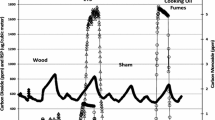Summary
In a previous paper, in which the experimental conditions of the present research are fully described (Parrot et al., this issue), heart rate (HR) was studied in 60 male and in 60 female subjects in response to a pile-driver noise (P), a gunfire noise (G), a road traffic noise (T), and an intermittend pink noise (R), all noises being emitted at the same LAeq = 75 dB for 15 min. Digital pulse level (PL) responses were concomitantly surveyed by the use of pulse oxymetry, allowing continuous arterial oxygen saturation (SaO2) readings. An index of pulse reactivity (PRI) could be calculated. Arterial blood pressure was measured 7 times from the beginning to the end of each trial. At rest, within the last minutes preceding each exposure to any of the 4 noises, no difference for conditions or for age in prestimulus PL was observed. In all cases, sex is a highly significant source of variation: Mean resting SaO2 values are higher in women than in men. Mean SaO2 at rest was also found to be significantly higher in anxious (Am) than in anxiety-free (Nm) men. When the noise was on for 15 min, ancrease in PL prevailed to be in most cases in men. In contrast, decrease or near-zero changes prevailed in 1 case out of 2 in the female subgroups. In all groups, the mean PRIs are significantly higher in men. In no case did the age factor prove to be a significant source of PRI variation. In AM and NM, amplitudes of PRI proved to be significantly different for the different noises: They are higher during exposure to T than during exposure to P, G and R ranking in third and fourth position, respectively. The same ranking of noises as regards pulse response induced is also met in women of the same age range. In YM and OM, too, T ranks first and before P for inducing the most important PR. In no case did anxiety prove to be a significant source of variation as regards the vasomotor responses. In all the cases, systolic and diastolic blood pressure (SBP, DBP) levels at rest were found to be significantly higher in men than in women. Under noise exposure a systematic decrease of SBP and DBP was observed as an overall tendency, but this change never achieved statistical significance and was without any significant after-effect. No significant role of anxiety was observed, but incidentally age was found to be a significant factor in DBP changes.
Similar content being viewed by others
References
Alexander CM, Teller LE, Gross JB (1989) Principles of pulse oxymetry: theoretical and practical considerations. Anesth Analog 68:368–376
Burton AC (1939) The range and variability of the blood flow in the human fingers and the vasomotor regulation of body temperature. Am J Physiol 127:437–453
Burton AC, Taylor RM (1940) A study of the adjustement of peripheral vascular tone to the requirements of the regulation of body temperature. Am J Physiol 129:565–577
Cohen A (1975) Extra-auditory effect of noise in Olishifski-Harford. Industrial noise and hearing conservation. National Safety Council, Chicago, pp 259–291
Di Nisi J, Muzet A, Ehrhart J, Libert JP (1990) Comparison of cardiovascular responses to noise during waking and sleeping in humans. Sleep 13:108–120
Jansen G (1973) Non-auditory effects of noise: physiological and psychological reactions in man. Proceedings of the International Congress on Noise as an Public Health Problem, Dubrovnik
Jansen G (1985) Noise induced health disturbance. In: Hommage au Professeur B. Metz. Centre d'Etudes Bioclimatiques du CNRS, Strasbourg, pp 9–111
Johnson L, Lubin A (1967) The orienting reflex during waking and sleeping. EEC Clin Neurophysiol 22:11–21
Keefe FB, Johnson LB, Hunter EJ (1971) EEG and autonomic response pattern during waking and sleep stages. Psychophysiology 8:198–212
Muzet A (1980) Modifications végétatives entraînées par le bruit au cours du sommeil. Rapport de recherche Sur contrat, convention no. 7622 du Ministere de l'Environnement. Centre d'Etudes Bioclimatiques du C.N.R.S., Strasbourg
Muzet A (1985) Comparaison de la réactivité cardiovasculaire au bruit au cours de la veille et du sommeil. Rapport de recherche Sur contrat, convention no. 82243 du Ministere de l'Environnement. Centre d'Etudes Bioclimatiques du C.N.R.S., Strasbourg
Muzet A, Ehrhart J, Eschenlauer R, Lienhard JP (1980) Habituation and age differences of cadiovascular responses to noise during sleep. In: Sleep, 5th European Congress on Sleep Research. Karger, Amsterdam
Petiot JC (1987) Réponses cardiovasculaires au bruit chez l'homme. Etude expérimentale des differences interindividuelles et de l'adaptation aux expositions répétées. Thèse de Doctorat d'Etat ès Sciences Naturelles, Université de Bourgogne
Pologe JA (1987) Pulse oxymetry: technical aspects of machine output. Int Anesthesiol Clin 25:137–155
Author information
Authors and Affiliations
Rights and permissions
About this article
Cite this article
Petiot, J.C., Parrot, J., Lobreau, J.P. et al. Cardiovascular effects of impulse noise, road traffic noise, and intermittent pink noise at LAeq = 75 dB, as a function of sex, age, and level of anxiety: a comparative study. Int. Arch Occup Environ Heath 63, 485–493 (1992). https://doi.org/10.1007/BF00572115
Received:
Accepted:
Issue Date:
DOI: https://doi.org/10.1007/BF00572115




